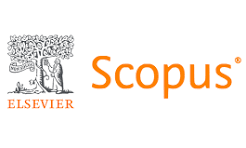EVALUATION OF FLEXURAL STRENGTH OF DENTURE-BASED MATERIALS REINFORCED WITH Al2O3, SiO2, TiO2, AND ZrO2 NANOPARTICLES: A SYSTEMATIC REVIEW AND META-ANALYSIS
Abstract
Background: With the introduction of nanotechnology in dentistry, the use of nanoparticles to strengthen acrylic resins has received much attention. The aim of the present study was to evaluate the effects of different percentages (1%, 2%, 3% & 5%) of Al2O3, SiO2, TiO2, and ZrO2 nanoparticles in acrylic resin on the bending strength.
Materials & Methods: The PRISMA 2020 Checklist was used to carry out a systematic review and meta-analysis as the basis for the current investigation. Up until 23 October 2022, systematic literature searches were conducted on Scopus, PubMed, EBSCO, Web of Science, ISI Web of Knowledge, and Embase. Then, a fixed-effect model and the inverse-variance method were been utilized to generate the 95% confidence interval for mean differences. Data from the meta-analysis has been analyzed utilizing Stata/MP v.17 software.
Results: A review of abstracts from 800 studies was conducted in the initial review of the study to eliminate duplicates; full texts of 391 studies were reviewed by two authors, and 14 studies were ultimately chosen. The mean flexural strength difference between the control group and the 1% Al2O3 reinforcement was -6.19 (MD, -6.19 95% CI -8.26, -4.11; p=0.00). The mean flexural strength difference between the control group and the 3% SiO2 reinforcement was 4.58 (MD, 4.58 95% CI 3.61, 5.56; p=0.00). The mean flexural strength difference between the control group and the 1% TiO2 reinforcement was -4.08 (MD, -4.08 95% CI -35.03, 26.87; p=0.80).
Conclusions: It can be concluded from the present meta-analysis that the properties of polymers reinforced with nanoparticles depend on their type and concentration.
Keywords
Full Text:
PDFReferences
Zafar MS. Prosthodontic applications of polymethyl methacrylate (PMMA): An update. polymers. 2020;12(10):2299. https://doi.org/10.3390/polym12102299.
Soleimani F, Yaghoobi N, Niakan S. Complete denture with sectional-tray approach in a microstomia patient: a case report and literature review. Int J Sci Res Dent Med Sci. 2021 Jun 5;3(2):94-100. https://doi.org/10.30485/ijsrdms.2021.279477.1141.
Machado C, Sanchez E, Azer SS, Uribe JM. Comparative study of the transverse strength of three denture base materials. J dent. 2007;35(12):930-3. https://doi.org/10.1016/j.jdent.2007.09.006.
Goldberg AJ, Burstone CJ. The use of continuous fiber reinforcement in dentistry. Dent Mater. 1992;8(3):197-202. https://doi.org/10.1016/0109-5641(92)90083-O.
Singh S, Palaskar JN, Mittal S. Comparative evaluation of surface porosities in conventional heat polymerized acrylic resin cured by water bath and microwave energy with microwavable acrylic resin cured by microwave energy. Contemp Clin Dent. 2013;4(2):147-51. https://doi.org/10.4103/F0976-237X.114844.
Aeran H, Kumar V, Uniyal S, Tanwer P. Nanodentistry: Is just a fiction or future. J Oral Biol Craniofac Res. 2015;5(3):207-11. https://doi.org/10.1016/j.jobcr.2015.06.012.
Price CA. A history of dental polymers. Aust Prosthodont J. 1994;8:47-54. https://doi.org/10.1016/0306-3747(94)90316-6
Durkan R, Oyar PE. Comparison of mechanical and dynamic mechanical behaviors of different dental resins polymerized by different polymerization techniques. Niger J Clin Pract. 2018;21(9):1144-9.
Gad MM, Abualsaud R, Al-Thobity AM, Almaskin DF, AlZaher ZA, Abushowmi TH,et al. Effect of SiO2 nanoparticles addition on the flexural strength of repaired acrylic denture base. Eur J Dent. 2020;14(01):19-23. https://doi.org/10.1055/s-0039-1701076.
Gad MM, Abualsaud R, Alqarawi FK, Emam AN, Khan SQ, Akhtar S, et al. Translucency of nanoparticle-reinforced PMMA denture base material: An in-vitro comparative study. Dent Mater J. 2021;40(4):972-8. https://doi.org/10.4012/dmj.2020-296.
Lakhanam M, Singh R. The Comparison of Shear Bond Strength of Orthodontic Brackets on Different Tooth Surfaces Bonded by Indirect Bonding Technique Using DT3C Device. Int J Sci Res Dent Med Sci. 2022;4(4):162-9. https://doi.org/10.30485/ijsrdms.2022.363437.1375.
Rahman IA, Padavettan V. Synthesis of silica nanoparticles by sol-gel: size-dependent properties, surface modification, and applications in silica-polymer nanocomposites-a review. J Nanomater. 2012;2012:8. https://doi.org/10.1155/2012/132424.
Priyadarsini S, Mukherjee S, Mishra M. Nanoparticles used in dentistry: A review. J Oral Biol Craniofac Res. 2018;8(1):58-67. https://doi.org/10.1016/j.jobcr.2017.12.004.
Ghasemnia B, Kordi S, Mehraban SH, Azizi A, Moravej A, Salehi M. Evaluation of the Success Rate of Endoscopic Sinus Surgery after Dental Implantation: A Systematic Review and Meta-analysis. Int J Sci Res Dent Med Sci. 2022;4(3):134-9. https://doi.org/10.30485/ijsrdms.2022.359443.1362.
Tu YK, Needleman I, Chambrone L, Lu HK, Faggion Jr CM. A Bayesian network meta-analysis on comparisons of enamel matrix derivatives, guided tissue regeneration and their combination therapies. J Clin Periodontol. 2012;39(3):303-14. https://doi.org/10.1111/j.1600-051X.2011.01844.x.
Higgins JP, Altman DG, Gøtzsche PC, Jüni P, Moher D, Oxman AD, et al. The Cochrane Collaboration's tool for assessing risk of bias in randomised trials. Bmj. 2011;343. https://doi.org/10.1136/bmj.d5928.
Omar MH, Amin MH, Younis HA. Comparison of using nano-ZnO and nano-Al2O3 to improve the properties of prepared polymethyl methacrylate denture base. Appl Phys A. 2022;128(4):313. https://doi.org/10.1007/s00339-022-05359-6.
Yesildal F, Kul E, Yesildal R, Matori KA. Investigation of the Thermal Conductivity and Flexural Strength of Polymethylmethacrylate Denture Base Material with SiC and Al2O3 Added. mater Plast. 2021;58(2):91-9. https://doi.org/10.37358/Mat.Plast.1964.
Aboshama M, Helmy N, Ammar M. Effect Of Flexural Strength Of Denture Base Resin Reinforced By Three Different Nanoparticle Materials (In Vitro Study). Al-azhar assiut dent j. 2021;4(1):31-6. https://doi.org/10.21608/aadj.2021.163878
Karci M, Demir N, Yazman S. Evaluation of flexural strength of different denture base materials reinforced with different nanoparticles. J Prosthodont. 2019;28(5):572-9. https://doi.org/10.1111/jopr.12974.
Hamad QA. Study the effect of nano-Al2O3 and fiber glass on mechanical and physical properties of PMMA composites for prosthetic denture. eng tech j. 2018;36(7 Part A). https://doi.org/10.30684/etj.36.7A.3.
Jiangkongkho P, Arksornnukit M, Takahashi H. The synthesis, modification, and application of nanosilica in polymethyl methacrylate denture base. dent mater j. 2018;37(4):582-91. https://doi.org/10.4012/dmj.2017-142.
Cevik P, Yildirim-Bicer AZ. The effect of silica and prepolymer nanoparticles on the mechanical properties of denture base acrylic resin. J Prosthodont. 2018;27(8):763-70. https://doi.org/10.1111/jopr.12573.
Salman AD, Jani GH, Fatalla AA. Comparative study of the effect of incorporating SiO2 nano-particles on properties of poly methyl methacrylate denture bases. Biomed Pharmacol J. 2017;10(3):1525-35. https://doi.org/10.13005/bpj/1262
Alnamel HA, Mudhaffer M. The effect of Silicon di oxide Nano-Fillers reinforcement on some properties of heat cure polymethyl methacrylate denture base material. J Baghdad Coll Dent. 2014;26(1):32-6. https://doi.org/10.12816/0015142
Tandra E, Wahyuningtyas E, Sugiatno E. The effect of nanoparticles TiO2 on the flexural strength of acrylic resin denture plate. padjadjaran J dent. 2018;30(1):35-40. https://doi.org/10.24198/pjd.vol30no1.16110.
Ahmed MA, El-Shennawy M, Althomali YM, Omar AA. Effect of titanium dioxide nano particles incorporation on mechanical and physical properties on two different types of acrylic resin denture base. World j nano sci eng. 2016;6(3):111-9. https://doi.org/10.4236/wjnse.2016.63011
Hamouda IM, Beyari MM. Addition of glass fibers and titanium dioxide nanoparticles to the acrylic resin denture base material: comparative study with the conventional and high impact types. oral health dent manag. 2014;13(1):107-12.
Harini P, Mohamed K, Padmanabhan TV. Effect of Titanium dioxide nanoparticles on the flexural strength of polymethylmethacrylate: An in vitro study. Indian J Dent Res. 2014;25(4):459-63. https://doi.org/10.4103/0970-9290.142531
Nazirkar G, Bhanushali S, Singh S, Pattanaik B, Raj N. Effect of anatase titanium dioxide nanoparticles on the flexural strength of heat cured poly methyl methacrylate resins: an in-vitro study. J Indian Prosthodont Soc. 2014;14(Suppl 1):144-9. https://doi.org/10.1007/s13191-014-0385-8.
Liu H, Brinson LC. A hybrid numerical-analytical method for modeling the viscoelastic properties of polymer nanocomposites. 2006;73(5):758-768. https://doi.org/10.1115/1.2204961.
Liu H, Brinson LC. Reinforcing efficiency of nanoparticles: A simple comparison for polymer nanocomposites. Compos Sci Technol. 2008;68(6):1502-12. https://doi.org/10.1016/j.compscitech.2007.10.033.
DOI: https://doi.org/10.46903/gjms/21.03.1332
Refbacks
- There are currently no refbacks.
Copyright (c) 2023. Kavan Yaghmoori, Navid Kerayechian, Amir Azizi, Negin Ghahremani, Farnaz Rezvan, Ali Amiri.

This work is licensed under a Creative Commons Attribution-NonCommercial 4.0 International License.

Gomal Medical College, Daraban Road, Dera Ismail Khan, Pakistan
ISSN: 1819-7973, e-ISSN: 1997-2067
Website: https://www.gmcdikhan.edu.pk
Phone: +92-966-747373


